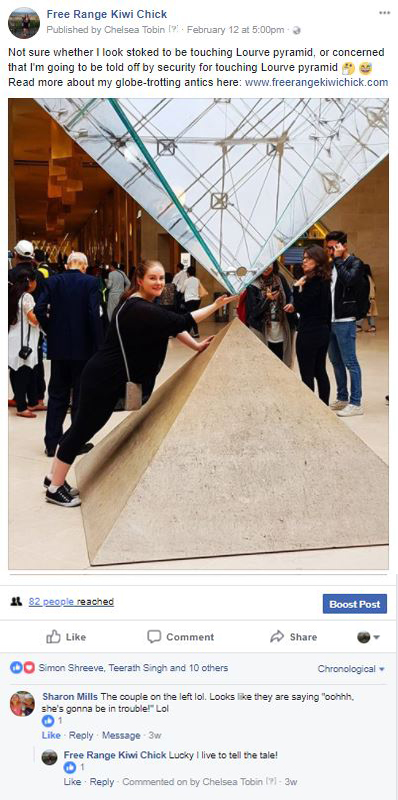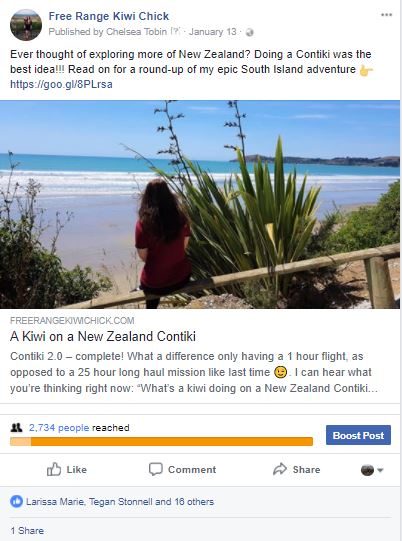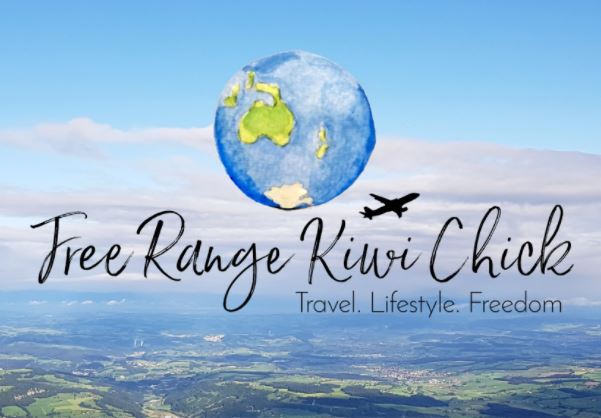The travel industry, particularly the travel blog realm, is saturated. Companies, bloggers and vloggers are competing for the attention of readers and customers.
That being said… I started my own travel blog in December 2017. Even though creating Free Range Kiwi Chick was a casual passion project and not primarily intended to be a stream of revenue, I still went in with a marketing mindset and a strategy on how I was going to disseminate my content on the corresponding Facebook and Instagram handles. My main goals were to:
- Grow an engaged following on social
- Drive more traffic to my website
- Collect data for a sales funnel: re-targeting a paid offer to a warm audience of readers
In this case study, I’ll focus on some key points on how I utilized both organic Facebook and paid Facebook ads to do this.
Organic Facebook: Key strategy points
Travel blog content is of course, mostly made up of blog posts. But on social media it’s still important to create & curate a wide variety of content. So the content that is shared is a mixture mainly made of:
- Blog posts
- Images (which includes engaging captions)
- Videos
- Related & appropriate content shared from other sources
On social media, content needs to fall under at least one of the ‘3 E’s’: Educational, Entertaining and Engaging.
For example:
- Travel tips – educational
- My “human” moments during my travels – entertaining
- Beautiful, inspiring imagery and videos – engaging

Your travel blog (or any website for that matter) will have it’s own ‘voice‘. You need to align your social media posts with this same voice and messaging to keep things consistent.
For example, my message is to be down-to-earth and relatable, while encouraging millennials to travel the world, even if it’s just for a small trip here and there. I want to inspire people that travel doesn’t have to be out of reach, is totally attainable – and is good for your soul.
Organic Facebook: Results
- Average engagement rate on posts: ~15 %
- Entertaining images + captions average over 20% engagement
- Average reach ~20% of followers
Facebook Advertising: Key strategy points
First and foremost, I installed the Facebook Pixel on my website to capture data from the ads and “season” the Pixel for re-targeting later on.
I ran ads using existing page posts (this is different to boosting posts – I sometimes ‘boost’ image posts that have high organic engagement). A huge benefit to using existing page posts for your ads is that the ‘social proof’ from the organic post (likes, comments, shares) are visible on the ad.
The existing page posts I used were:
- The post linking to my blog about my NZ Contiki trip
- The post linking to my blog about 20 travel tips & tricks
In Facebook Business Manager, I created custom conversions of the link of each blog post, so I can track results and capture data of how many people have viewed these blog posts because of my ads.
Facebook Advertising: Results
An example: NZ Contiki blog with the objective of link clicks through to my website, so I can turn a cold audience into a warm audience.

- Amount spent: $15 NZD total (over 6 days)
- Relevance score: varied from 9-10
- CTR (Click Through Rate): averaged 4.6% (highest CTR was 7.7%!)
- Cost Per Results: averaged $0.137
- Impressions: 5168
How did I get these results? Three keys:
- Copy and creative of the ad was striking and relevant to the audience
- The cold audience was targeted well (pro-tip: narrow your audience with a more defined selection. For example, my audience of NZ women aged 18-26 years old had to not only be interested in travel, but must also be interested in Contiki).
- The blog itself was useful and engaging
From the data captured using the pixel, I created custom audiences of:
- People who had read these blog articles
- Engaged with my Facebook page
- I also created a custom audience of video viewers who watched over 25% of my NZ Contiki video.
These are now ‘warm audiences’ who I can re-target with other ads and offers.
Next steps: Get readers down the sales funnel
- Next I will create a lead magnet (most likely a PDF document)
- Re-target these warm audiences who have read my blog posts or watched my videos, with ads to download this lead magnet – and get them onto my email list.
- Nurture this email list by providing more, exclusive value.
- Then re-target this email list via email and a Facebook ad to promote my offer of an E-book to buy.
I hope this gave you some insight into the social media strategy around my travel blog and what is possible with getting your readers further down the sales funnel and converted into buying customers!
Note: This article touched on the main points I thought were most useful to talk about before the article got too long – of course there are more actions that go into a successful social media marketing strategy.

